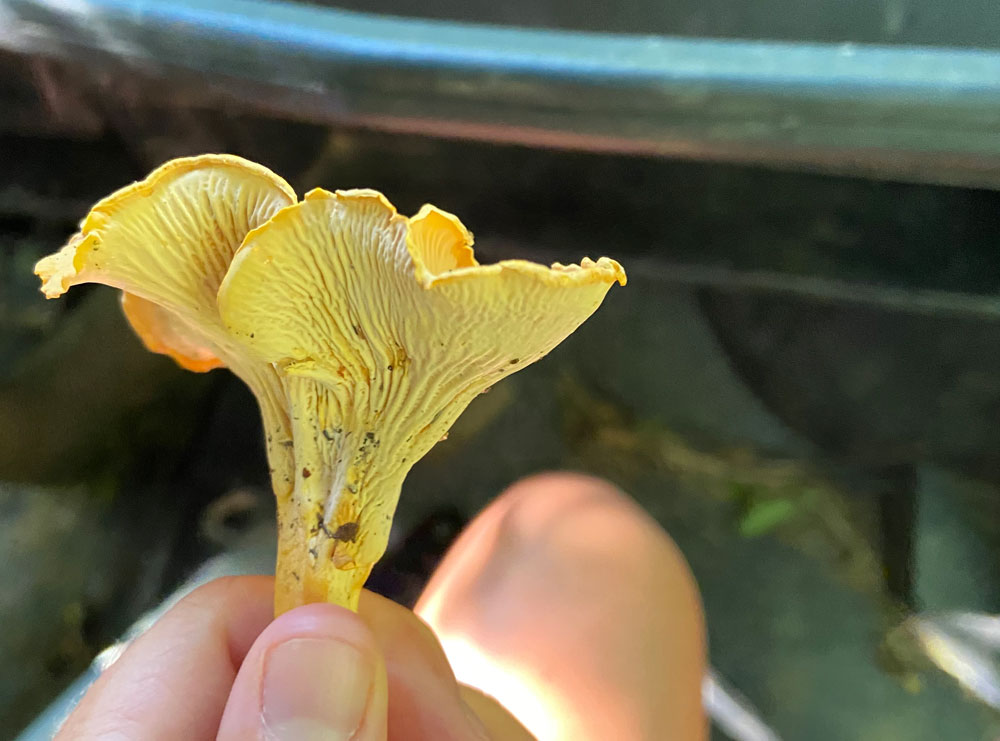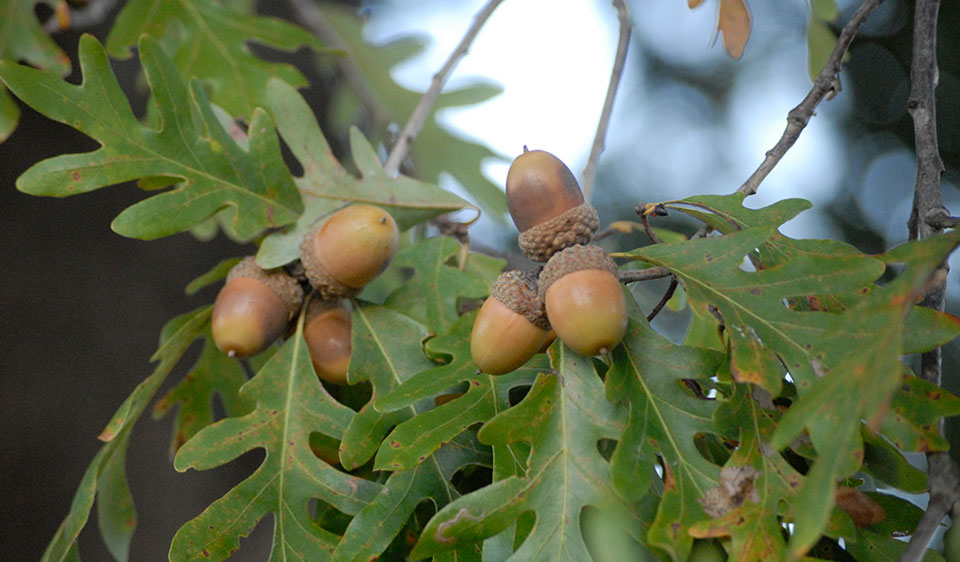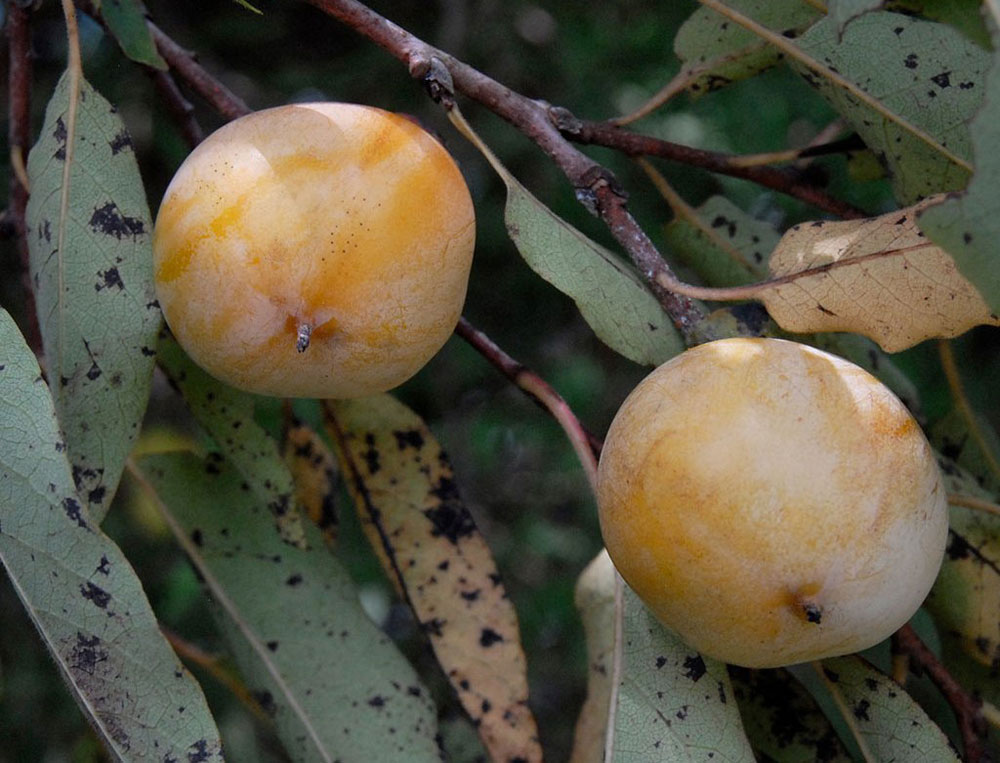Fall is a beautiful season full of golden leaves and deep-red sunsets. Whether you’re in the great outdoors hiking, camping, hunting, or fishing, you’re bound to encounter tasty-looking berries, nuts, and fungi.
It might be tempting to take a bite of the first berry you see, but do your research first. Not all food you see in the wild is safe to eat. Before you go out foraging, brush up on your plant and mushroom identification skills first.
Here are four wild edibles to look for when you’re foraging for food this fall.

1. Chanterelle Mushrooms (Cantharellus Cibarius)
Chanterelle mushrooms are one of the most popular wild edibles available. These tasty and rare mushrooms are found all over the world. The season starts in July, but you can find these delicious fungi through December, although they’re harder to find after early autumn. They thrive in a moist environment and are more abundant after heavy rains.
Characteristics: You can identify a chanterelle mushroom from its false gills. Unlike button mushrooms, chanterelles have fine wrinkles on the cap’s underside, and you won’t be able to remove the stem without ripping it. The caps are vase-shaped and dark yellow.
Where to Look: Like many fungi, chanterelles live close to the ground. Watch your feet in hardwood forests. Chanterelles are solitary mushrooms and rarely grow in large bunches. Old-growth forests of oak, poplar, beech, and birch with a dense canopy are the best location for chanterelle foraging.
Preparation Ideas: Sauté them in butter with salt and pepper, throw them in a chili con carne, or make a mushroom bourguignon. Chanterelles have a wonderful meaty, chewy flavor that adds an earthy depth to any dish. Don’t eat them raw, as they can cause digestive distress.
Look-alikes: Don’t be tricked by the Jack O’Lantern or the False Chanterelle. Neither are deadly, but they will make you sick and taste bitter.
While a similar color, the Jack O’Lantern has true gills and often grows in large groups. The False Chanterelle also has true gills, although they do have some wrinkles at the top. They also tend to be a darker orange than a Chanterelle.
2. Persimmons (Diospyros)
Persimmons are packed with Vitamin C and edible raw or baked into delicious tarts. Depending on your climate, the fruits begin to ripen around September, and the season continues until around December. If you can harvest the berries just before they mature, you will get the best results.
Typical Characteristics: Commonly found near streets, fields, or streams, persimmon trees can grow between 40-80 feet tall. The branches form in a zig-zag pattern, and you can identify the tree by its large, oblong, and dark shiny green leaves.
Depending on the species, the fruit can be orange or purple and around two inches in diameter. Their smooth skin becomes wrinkled when ripe.
Where to Look: The American Persimmon Tree is native to the east coast of the U.S., but you can find the Japanese variety on the west coast. They grow in many types of forests but prefer moist soil on upland sites. You can typically find them growing between sycamore, hickory, and sugar maple trees.
Preparation Ideas: There are numerous ways to prepare the persimmon berry, ranging from baked goods to grinding the seeds up for your morning coffee. You can also eat them raw—just make sure they are soft and ripe first, or they will be sour. Persimmon berries also make a lovely jam for wintery mornings.
Look-alikes: You’re not likely to run into any dangerous persimmon look-alikes. However, be aware that there are astringent (acorn-shaped) and non-astringent (tomato-shaped) varieties. You can eat the non-astringent types before they are ripe, but astringent persimmons must be left to ripen unless you don’t mind a stomachache.
3. Wild Carrot or Queen Anne’s Lace (Daucus Carota)
Queen Anne’s Lace flowers are not only stunning to look at and useful for natural dyes, but they are also edible. In the fall, you can dig up the roots and cook them like you would carrots; hence, the nickname Wild Carrot. The roots will bring an earthy and intense flavor to any dish you add them to.
Typical Characteristics: The Queen Anne’s Lace flower is identifiable by its hairy stems, long stalk, and umbrella-shaped clusters of tiny white blooms with a small red dot in the center. The petals form a flat top, and the white root smells distinctly of carrots.
Where to Look: Queen Anne’s Lace can be found almost worldwide and, in some states, is considered a weed. They usually grow in dry fields.
Preparation Ideas: Try to get younger roots, as older roots tend to be tougher. Peel the root and use it as you would carrots. It can be a lovely addition to a stew, soup, or bolognese. You can use the seeds to add additional flavor. You can dry and crush the roots for use as a coffee substitute, or use the flower heads to make jelly.
Look-alikes: Queen Anne’s Lace belongs to the same genus as hemlock, which is deadly. However, while Queen Anne’s lace has a green stem, the hemlock plant’s stem features purple blotches. The umbrella-shaped hemlock flower also has a slightly domed top rather than flat like Queen Anne’s Lace. If you’re not one hundred percent certain of its identification, don’t eat it.

4. Acorns
We all know that squirrels love acorns, but did you know humans can eat them too? You’ll need to process them first, but there are tons of possibilities once you do.
Typical Characteristics: Acorns come from oak trees, and the type of oak tree determines the taste, protein content, and fat content of the acorn. If you’re out in the woods, pick up a few acorns and take a picture of the tree. When you start processing them, you can work out the type of tree and research how best to use them.
Where to Look: Head to your nearest oak tree and look down. The acorns are the small, pointed, hard, brown nuts at the base of the tree. Generally, as long as they are on the ground, they are ripe.
All varieties of acorns are edible, but some have higher levels of tannins than others, changing the taste.
Preparation Ideas: Before eating, you’ll need to sort, dry, shell, and leach the acorns. To sort them, place them in water and discard those that float. Dry the remaining acorns and use a hammer to remove the outer shell.
Last, you need to leach them to remove the tannins by soaking them in warm water and changing the water when it turns a dark brown color. You will need to repeat this step until the water runs clear.
After they’re leached, you can cut or grind the acorn meat for flour, soup, pancakes, or even cookies.
Look-alikes: You’re unlikely to mix up acorns with any other type of nut, but keep a lookout for acorns with tiny holes. Holes indicate the presence of insects. You can also mistake buckeyes for shell-less acorns. Buckeyes are poisonous, so only select acorns still in their shell for consumption.
Go Forth and Forage
Foraging wild edibles can be an exciting experience and an excellent way to find sustainable, local food. Just be sure to triple check that your foraged goods are definitely edible and not dangerous. Always bring along a guide book or photos as a backup.




























